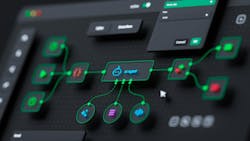What Engineering Teams Need to Know About Codebeamer 3.0 and ALM Compliance
Product development continues to become more complex and software-driven, making engineers look for better ways to manage requirements, testing, and traceability to keep projects up to speed. In this Q&A, New Equipment Digest spoke with Christoph Braeuchle, General Manager of Application Lifecycle Management (ALM) at PTC, to learn about Codebeamer 3.0, PTC's new ALM platform. Christopher discusses how teams are able to work at a faster pace by reducing manual tasks and easily meeting compliance goals, especially in highly regulated industries.
New Equipment Digest [NED]: To start, could you briefly explain what Codebeamer is and what makes the new Codebeamer 3.0 release so significant? Why is it being called a 'fundamental reset'?
Christoph Braeuchle [CB]: Codebeamer is an Application Lifecycle Management (ALM) software tool that helps engineering teams manage the entire product design process by simplifying workflows and providing flexible collaboration. It combines systems engineering and software development processes, including requirements and test management, quality assurance, and traceability & audit reporting for regulatory compliance, within a single environment.
We call version 3.0 a "fundamental reset" because it introduces big improvements in how teams manage system complexity and variability, how they collaborate at scale, and ensure traceability. Features like Scaled Working Sets and Modern Branching cut down on manual tasks and make it easier to reuse work, which speeds up development and keeps everything compliant with regulations.
NED: Who exactly is Codebeamer 3.0 designed for? Which kinds of companies or engineering teams will get the most value out of it?
CB: Mostly, engineering teams involved in complex product development, often with software-driven innovation. Companies in regulated fields—like medical devices, automotive, aerospace, and defense—will benefit most because they need strict control over versions and compliance. Teams managing multiple product versions or spread across different locations will especially find the tool helpful.
NED: Does Codebeamer 3.0 work independently as an Application Lifecycle Management (ALM) tool, or do users need other PTC products, like Windchill PLM, to fully utilize its main features?
CB: Codebeamer 3.0 works perfectly fine on its own—you don't need other PTC tools to get started. But if you already use Windchill PLM, the two can connect to give you full visibility over your entire product lifecycle, from design all the way through maintenance. Plus, Codebeamer can also work with other third-party tools thanks to its open architecture.
NED: Let's dive into the key features. One key update is Scaled Working Sets. Can you explain these and how they help teams keep track of requirements, tests, and traceability, especially when juggling different product variants?
CB: Scaled Working Sets group all the important development info—like requirements, test cases, risk analyses, and trace data—into one neat, reusable package. This makes it easier for teams to keep everything organized, speed up development, and reuse work across different product versions. Even if you have hundreds of thousands of items, it helps teams stay on top of it all and stay compliant.
NED: Another update is the Modern Branching Method. How is this different from traditional branching, and what benefits does it offer for collaboration, reusing work, and overall efficiency?
CB: Traditional branching copies entire datasets, which takes up a lot of storage and slows things down. Modern Branching only tracks the actual changes at the data level, so it saves space and works faster. This allows multiple people to work on different branches at the same time without interfering with each other. It also helps teams move away from "clone and own" by letting them reuse approved parts more strategically. Plus, it can automatically spread fixes or updates across different product variants, saving time and reducing errors.
When combined with Scaled Working Sets, these features simplify version control, cut down on manual work, and keep development consistent and compliant.
Consider an automotive manufacturer producing multiple variants of a vehicle model. Instead of duplicating data for each version, teams can use Scaled Working Sets to carry over validated requirements, tests, and risk assessments.
With Modern Branching, they can create new development branches from a shared base without increasing storage or rework. When they make improvements or add features, they can update everything easily across versions. This approach speeds up development, cuts down mistakes, and makes it simpler to stay compliant.
NED: Traceability is key for compliance. How can teams still track everything from start to finish, even when they're working faster and doing more work in parallel?
CB: Codebeamer 3.0 makes sure that none of the critical trace information gets lost by embedding the trace mechanisms into Scaled Working Sets and supporting granular change control through Modern Branching. Every requirement, test case, and risk item remains connected across branches and updates, giving teams a consistent, auditable view of development history—even in fast-moving or highly parallel workflows.
NED: Codebeamer 3.0 also has a new Sustainability Template. What kind of guidance or functionality does it provide, and how does it help teams build sustainable practices into their day-to-day work?
CB: The Sustainability Template helps teams include eco-friendly thinking in their product development. It includes guidance on eco-friendly design strategies, material selection, and regulatory requirements. Overall, it helps reduce how many physical prototypes teams need to make and tracks sustainability progress automatically, so it's easier to measure and repeat those efforts.
NED: What was the main driver behind developing these specific features for Codebeamer 3.0? Was it mostly hearing from customers, seeing where the market was headed, or breakthroughs from your own R&D team?
CB: A combination of all three of these motivated these features for Codebeamer 3.0. Besides feedback from key customers, we also saw the opportunity to leverage our newly acquired Pure Variants technology to automate what we call 'variant transformation'. Making this work at scale was the leading reason why we thought it was time to create a new version. We wanted to offer new customers a solid, modern ALM tool and give current users ways to work more efficiently. Plus, these updates lay the groundwork for integrating AI and tighter PLM connections in the future.
NED: What's involved for companies looking to switch to Codebeamer 3.0, maybe from older systems, spreadsheets, or even previous Codebeamer versions? Especially when it comes to getting used to these new features and workflows?
CB: We have made sure that upgrading is smooth and that the new features fit naturally into existing workflows. Nevertheless, the upgrade should be planned in collaboration with our partners and PTC experts. Companies looking to integrate Codebeamer 3.0 into their product development systems have an opportunity to evaluate their current processes, identify gaps, and pinpoint areas where Codebeamer can help address existing challenges. We provide training and support to help engineers learn the new system quickly and get the most out of it.
NED: Looking ahead, you mentioned AI and better integration with other PTC tools. What specific kinds of AI help do you see coming to Codebeamer? And how will linking it more closely with the PTC ecosystem give users an edge they couldn't get with separate ALM/PLM tools?
CB: The most value for AI in Codebeamer is focused on two key areas: improving requirements and test case quality, and streamlining validation and regulatory compliance. Engineers will get AI-powered support for authoring, decomposing, and reusing requirements, as well as assistance with traceability and homologation tasks. A prime example is Codebeamer AI beta, developed in collaboration with Microsoft and the Volkswagen Group, which helps generate and validate specifications while reducing duplication and ensuring compliance with standards.
As Codebeamer integrates more deeply with tools like Windchill, these AI capabilities will enable a connected digital thread that automates documentation and speeds up decision-making across the product lifecycle—something you won’t get if your ALM and PLM tools are separate.
About the Author
Laura Davis
Editor-in-Chief, New Equipment Digest
Laura Davis is the editor in chief of New Equipment Digest (NED), a brand part of the Manufacturing Group at EndeavorB2B. NED covers all products, equipment, solutions, and technology related to the broad scope of manufacturing, from mops and buckets to robots and automation. Laura has been a manufacturing product writer for eight years, knowledgeable about the ins and outs of the industry, along with what readers are looking for when wanting to learn about the latest products on the market.


